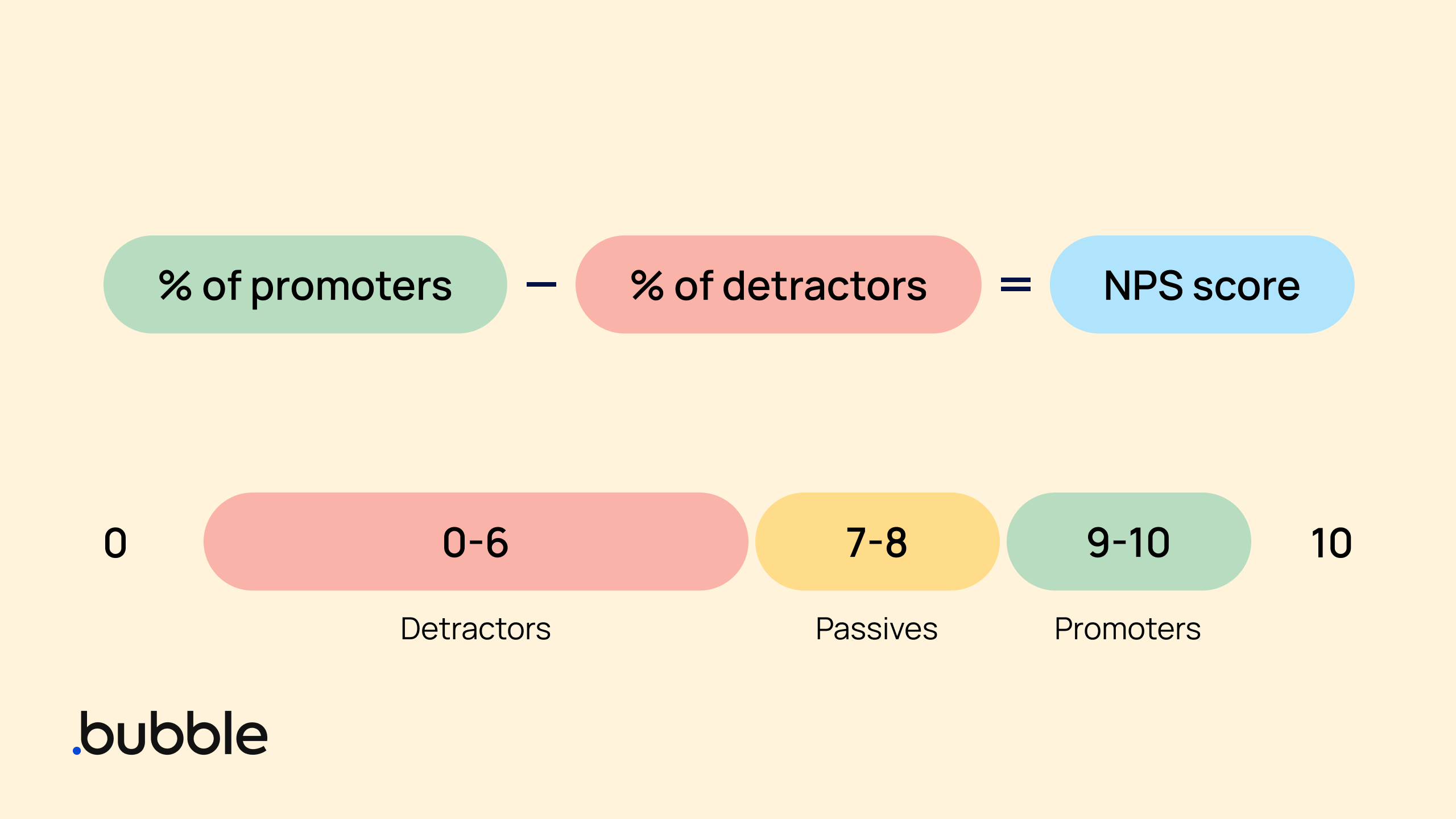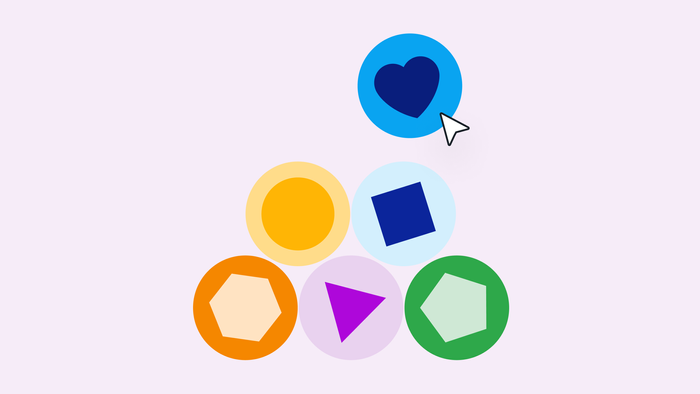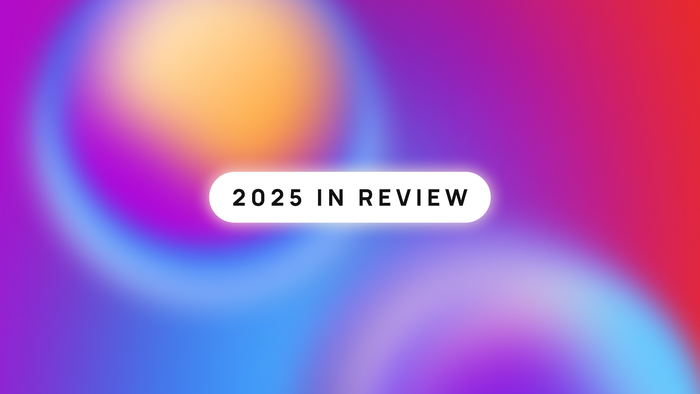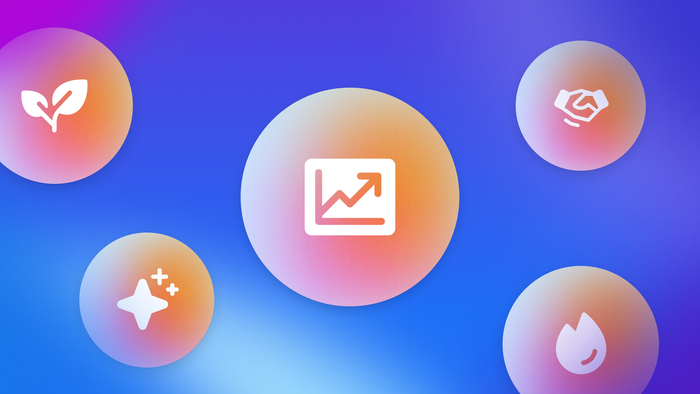We all have brands we’re loyal to. When you need to buy a new phone, tube of toothpaste, or pair of socks, you probably don’t need to do much shopping around.
Instead, you buy your trusty favorite.
That level of customer loyalty is what we all aspire to when we’re building our own products and services — being the go-to brand that our customers think of so that they keep coming back again and again.
Customer loyalty can have a big impact on your business.
According to research from the Harvard Business Review, companies who are “loyalty leaders” — at the top of their industries as measured by customer satisfaction — grow revenue 2.5x as quickly as other companies in their industries.
The question is: How do you build that level of customer loyalty?
We’ll break it down in this article:
- How to measure customer loyalty
- Customer loyalty benchmarks
- Customer loyalty tools
- How to increase customer loyalty
- 7 popular customer loyalty program ideas
How to measure customer loyalty: 5 key metrics
Before you can make a true effort to improve your customer loyalty, you need an idea of how to to measure it and chart your progress.
Otherwise, not only will you have little sense of what’s working, you won’t even know what “working” means.
These five core customer loyalty metrics will give you a good place to start.
Net Promoter Score (NPS)
Net Promoter Score (NPS) measures how likely customers are to recommend your brand, product, or services to friends and family. It gives you a quantitative way to measure customer loyalty and brand affinity.
A more loyal customer base is more likely to recommend your brand. This makes measuring NPS a clear way to chart customer engagement over time.
To get your NPS score, you’ll run a simple survey. Customers rate how likely they are to recommend your brand on a scale of 1–10. Then, your team will group respondents into three categories:
- Detractors (wouldn't recommend, or would recommend against)
- Passives (may or may not recommend)
- Promoters (would actively recommend)
Anyone who answers between 1–6 is a detractor. 7s or 8s are passives, and 9s or 10s are promoters.
Then, calculate the percentage of each group. You can then calculate your overall NPS score with the following formula:

So, if 40% of your respondents are promoters, and 20% are detractors, your NPS score would be 20.
Customer Lifetime Value (CLV)
Customer Lifetime Value (CLV) measures how much value (or revenue) you can expect to earn from a single customer over their “lifetime” with your brand.
In theory, the longer a customer stays with your brand, the more purchases they'll make (and thus, the higher their CLV). Tracking your CLV can help you see how loyal customers are to your company. It can also help you make sure you’re not spending too much to acquire new customers.
CLV is calculated with the following formula:
The average customer lifespan is how long the average customer tends to stick with your brand.
The customer value is the average number of purchases a customer makes in a given timeframe multiplied by the average value of a purchase.
So, let’s say you're running an e-commerce platform. The average customer purchases five items per year, and the average purchase is $15. Generally, customer engagement with your brand lasts for two years.
In this case, CLV would look like:
The CLV is $150.
Repeat Purchases
Repeat purchases measures the average number of repeat purchases a customer makes, either in a given time period (i.e., annually) or over the entire customer lifespan.
Repeat customers spend 31% more on purchases than new customers and are 64% more likely to purchase more often. So measuring the number of repeat purchases shows you both how loyal your customers are, and how loyalty is growing over time.
To measure it, simply divide the number of purchases made by repeat customers by the total number of repeat customers.
So if you have 1,000 customers who made 2+ purchases in the past year, and the total number of purchases within this group is 4,289, then the average number of repeat purchases is 4.2.
If, for example, your previous year’s repeat purchases were 2.2, it’s a sign of increased customer loyalty.
Customer Retention Rate (CRR)
Customer Retention Rate (CRR) measures the percentage of customers your business retains over a given period. It’s especially helpful for companies or products that use a subscription model.
To calculate CRR, you’ll need to know three numbers:
- CE = number of customers at the end of the period
- CN = number of new customers during the period
- CS = number of customers at the start of the period
Then, you can use the following formula:
For example, let’s say you have a SaaS tool using a monthly subscription model. At the beginning of 2023, you had 450 users. Throughout Q1, you gained 150 new users. At the end of Q1, you have 580 users.
In this example, the company keeps 95% of their customers, which indicates extremely high customer loyalty.
You can also measure customer churn rate by taking the inverse of your retention rate to see how many customers are “lost” during a given period. For example, if you’ve retained 95% of your customers, then you have a churn rate of 5%.
A good churn rate varies by industry, but a churn rate that decreases over time indicates increased customer loyalty.
Customer Satisfaction Score (CSAT)
Customer Satisfaction Score (CSAT) is a measure of how satisfied customers are with a specific interaction, purchase, or experience with your brand. It’s good for tracking big-picture trends over time.
The more satisfied customers are with the customer experience, the more likely they are to return. This makes CSAT a good indicator of future customer loyalty.
It’s typically measured via a one-question survey where the customer indicates how satisfied they are with a recent experience on a scale of 1–5. Then, you can use the following formula to measure CSAT:
If you’re struggling with customer loyalty, sending out CSAT surveys at various touchpoints in the customer journey (i.e., after a purchase, after a customer service interaction, etc.) can help you pinpoint where customers are becoming dissatisfied. Then you can improve those areas to reduce churn.
Customer loyalty benchmarks and statistics
Customer loyalty affects a lot in your business, from revenue and growth to acquisition costs, satisfaction, new product adoption, and more.
Take a look at some key customer loyalty stats:
- 73% of customers are more likely to recommend a brand that has a great loyalty program.
- 59% of US consumers say once they’re loyal to a brand, they’re loyal for life.
- 68% of consumers are willing to spend more to maximize their loyalty points or earnings.
- Loyal customers spend 43% more money with their favorite brands.
- 52% of customers will go out of their way to purchase with a brand they’re loyal to.
Although benchmarks can vary significantly by industry, the following benchmarks can give you an idea of what to aim for as you’re starting:
We’ve left off CLV and Repeat Purchases from this table since they vary so widely by industry.
For example, a SaaS product with a monthly subscription might have an average of 15 repeat purchases per customer (since they are purchasing a subscription every month). A successful small business might have an average repeat purchase of only two.
Customer loyalty tools
Sometimes you’ll want a specific tool or software that can help you track customer loyalty, implement a loyalty program, or otherwise build loyalty among your customer base.
Here are two key types to consider:
Loyalty program software
Most loyalty programs, including points-based, tiered programs, and paid memberships, require some sort of software to manage the program. A good loyalty program software will allow you to:
- Open the program to new users
- Create special campaigns, deals, and offers
- Set up personalized offers
- Create rules for rewards and perks
- Set up points- or tiers-based rewards systems
- Track and analyze program metrics
Some great loyalty program software options include Talon.One, SpotOn, or Open Loyalty.
Customer satisfaction software
Customer satisfaction software makes it easier to run CSAT and NPS surveys, and otherwise measure customer loyalty and sentiment.
Ideally, this software will allow you to:
- Run automatic, recurring surveys
- Measure and analyze results of your customer data
- Find common complaints or problems to address
- Gather customer feedback across various channels or touchpoints
Some great options include Qualtrics, Delighted, or Survey Sparrow.
If you’re building your product on a no-code tool like Bubble, you can integrate a brand loyalty program directly within your app or product, making it even easier to improve customer loyalty. For example, on Bubble, you can use plugins and integrations to seamlessly blend customer testing, feedback, and loyalty tools into your app.
For example, you might want to try Rewardful for affiliate and referral programs, or check out Bubble's plugins and integrations for more options.
How to increase customer loyalty
Increasing customer loyalty often takes time — but don’t give up!
With an effective strategy in place, you can make small gains over time to promote customer loyalty, which will pay dividends in the long run.
Build your customer loyalty strategy
Building a strategy has three main steps:
1. Figure out where you are
To track and grow your customer loyalty, you need some internal benchmarks to see if you’re improving or declining.
Determining your current level of customer loyalty can also help you set more meaningful goals (i.e., should you focus first on reducing churn? Or do you want to improve repeat purchases or word of mouth marketing first?).
To figure out where you’re at currently, start with:
- Running an NPS and/or CSAT survey to get a general satisfaction benchmark.
- Use internal data to understand your current retention and churn rate.
- Calculate your CLV (if applicable, it may not be if you’re a new startup!)
Then, use the benchmarks in the section above (or look for industry-specific benchmarks) to assess how each of those numbers stacks up to averages.
If you’re still new enough that you don’t have much hard data yet, you can still run an NPS or CSAT survey on your existing customer base — or talk to customers one-on-one — to get an idea of overall satisfaction and loyalty.
2. Set goals for where you want to be
Focusing on what you’d like to achieve by improving customer loyalty will help you set better goals.
Of course, you want to create more loyal customers.
But what’s behind that? Maybe you want to:
- Expand your audience through more word-of-mouth referrals
- Increase customer retention or decrease churn
- Grow your customer lifetime value
- Improve customer satisfaction to create more loyalty
Once you know your primary objective, you can set clear, actionable goals that'll allow you to measure your success (or pivot tactics as needed).
3. Determine how you’ll get there
With your end goal in mind, you can now determine the tactics or approaches you’ll use to bridge the gap between where you are and where you want to be.
For example, if you want to increase your retention rate, and currently see about 60% of your customers churn after the first 60 days, you can assess which loyalty strategies and techniques will be most productive to reduce churn.
Maybe it’s creating a loyalty program. Maybe it’s something “unrelated,” such as providing more user directions and prompts within the app to get users onboarded faster.
If you’re building on Bubble, our no-code development tools give you freedom to iterate on your app more quickly based on your research and customer feedback. That way, you can quickly adjust your tactics based on what’s working.
Either way, diagnosing the goal and the current problem will help you find the most effective strategies to support your goal.
The psychology of customer loyalty
Before you dive into any specific loyalty program or tactic, it’s important to understand how customer loyalty works.
In general, most strategies for building customer loyalty fall into two buckets: rewards or rescues.
Rewards are positive reinforcement. When the customer takes a desired action or behavior (i.e., referring a friend or making a purchase), they get something nice (e.g., store credit or a free item).
Rescues are a subset of negative reinforcement, a way of the customer “escaping” from something which they don’t want to have happen. For example, if the customer spends more with your company, they might get access to special discounts (which rescues them from paying more), prioritized customer support (which rescues them from long waits on hold), or free shipping (which rescues them from the annoyance of shipping fees).
Customer loyalty programs use either rewards or rescue techniques to improve retention. Keep in mind that, in many cases, customer loyalty is an ongoing loop — meaning that in order to get loyal customers, you can’t just reward them once they’re already loyal. You also have to start out by being the kind of brand customers want to be loyal to.
This can look like providing great rewards or rescues after a customer takes a desired action. It can also look like providing great rewards or rescues that encourage customer loyalty, for example, always offering free shipping on bulk orders or providing extraordinary customer service.
For example, nearly 80% of consumers have changed brands following a poor customer service experience. This means that, in many cases, delivering the reward or rescue can create loyalty in the first place, not just reward it.
Consider your audience’s goals and pain points, and implement rewards and rescues accordingly.
7 popular customer loyalty programs
One study found that the CLV of customers that used loyalty program rewards was 6.3X higher compared to customers who weren’t part of the loyalty program.
Even better news: There are many different types of loyalty programs, no matter your product, service, or business model.
Customer loyalty cards (aka “punch cards”)
Customer loyalty cards are most often used at local businesses like coffee shops and small restaurants.
Typically, you get a “punch” for each purchase, and after a certain number of purchases, you get a discount or a reward (often a free drink or item).
Pros:
✅ Simple, familiar, and visual reward system makes it super easy to use
✅ Works well for businesses with the potential for high numbers of repeat purchases
Cons:
❌ Difficult to use for companies with high price points or low purchase frequency (e.g., airlines or software)
❌ Can take a long time to earn rewards
❌ Encourages repeat purchasing, but not necessarily purchase value
Points-based programs
Points-based customer loyalty programs are probably the most popular of all. Unlike punch cards, they’re endlessly customizable and can work for a wide range of businesses and business models.
They’re also super easy for customers to understand, and you can customize the points-earning and rewards systems any way you like.
Customers earn points, either through purchases or other tasks (e.g., liking your brand on social media or referring a friend). Those points then add up to rewards, such as discounts or free items. The more participants spend with your brand, the more rewards they can earn, which creates a positive feedback loop that reinforces loyalty and increases basket size.
Many consumer brands use points-based programs, such as Starbucks, Chipotle, the Body Shop, and so on. Most airline mileage programs also use a points-based system.
Pros:
✅ Can be as simple or as complex as you like
✅ Works with almost any business model or product type
✅ Ability to set up different types of rewards and ways to earn points
✅ Can be combined with other program formats, such as tiered-based and referral programs
Cons:
❌ Usually requires a specific software to manage
❌ Giving customers a satisfying points-to-rewards ratio can be challenging
Tiered programs
Tiered programs allow customers to work their way into higher and higher tiers with better rewards, usually based on how much they’ve spent.
For example, spending $0–100 in a year might move someone into the “Bronze” tier. Spending $101–250 might put someone in the “Silver” tier, and spending $251+ might put someone in the “Gold” tier.
Sephora’s Beauty Insider program is a great example. Higher tiers include higher discounts on sales, exclusive deals throughout the year, early access to new products, points multiplier events, and more.
By using a tiered system, you can use both rewards and rescue tactics. For example, you can reward customers with extra points, sales, discounts, and so on. You can also rescue them by providing perks like free shipping, or early access to sales or products (avoiding waiting for new releases or having them sell out).
Pros:
✅ Allows customers to earn more varied rewards compared to points-based systems
✅ Works with many different business models
✅ Tiers can provide any number of rewards, or “rescue” customers from common irritations
✅ Can be combined with other program formats, such as points-based programs
Cons:
❌ Usually requires specific software to manage
❌ It can be difficult to balance the rewards in each tier
Mission- or charity-based programs
Mission-based programs allow customers to feel like their purchases from you are doing something good for the world. Bombas, the popular sock brand, is a great example of this type of program. For every item purchased, Bombas donates an item to a homeless shelter in the US.
The customer’s reward here is less direct than traditional loyalty programs: Instead of getting a discount or a freebie, they get to feel like their purchasing behavior makes a difference. For many consumers — especially Gen Z and Millennial shoppers — this is important.
Some studies have found that as many as 90% of Gen Z shoppers are more likely to be loyal to brands that display similar values to theirs. If your brand has strong values in a certain area or the ability to give back, a mission-based program helps you clearly and tangibly communicate that to your audience. It’s not only good for the causes you care about — it can also cultivate customer loyalty.
Pros:
✅Strengthens loyalty among values-conscious shoppers, especially younger generations
✅Can be very simple to reward (i.e., one-for-one models)
✅Allows customers to feel like they’re part of a larger community
Cons:
❌ Can be very difficult to manage large-scale giving effectively
❌ Is difficult to connect with many types of items or business models
❌ Doesn’t reward ongoing loyalty any differently than a one-time purchase
Paid membership programs
Paid membership programs are a loyalty program that has a one-time or subscription-based membership fee. Rather than earning points or moving up tiers based on purchases, customers purchase access into the membership program to get benefits or earn rewards.
Although it may seem counterintuitive, these programs can be widely successful.
Amazon Prime is probably the most well-known example of this. (Case in point: About 1 in 2 people in the US have their own Amazon Prime subscription!) The REI membership is another example. For a $30 lifetime membership, members get access to exclusive deals, discounts on services, longer return windows, and 10% back on all regularly-priced purchases.
These programs both rescue customers from annoyances like short return windows or longer shipping times, and provide exclusive rewards and sales. In turn, these programs encourage customers to spend more to “max out” their rewards.
And because customers are paying extra in advance for the rewards, they tend to be more loyal to the brand. A McKinsey study found that members of paid loyalty programs are 60% more likely to spend money with a brand (compared to 30% for members of free loyalty programs).
Pros:
✅ Provides immediate revenue up front when customers sign up
✅ Offers a simple, customizable model (one way to join, endless reward options)
✅ Customers usually earn rewards on every purchase
✅ Shown to increase customer loyalty for those in the program
Cons:
❌ Upfront cost makes it more difficult to get new customers to join
❌ Can be difficult to match the value of the rewards to the price point of entry
Referral programs
Referral programs reward existing customers for referring new ones. This is often facilitated via a unique referral code or link that allows new signups to be traced back to a referrer so a reward can be granted.
Common rewards include product credits, discounts on future purchases, or points for a larger rewards program.
Airtable is a great example of a referral program. For every person that signs up for Airtable using a customer’s unique referral link, the existing customer receives $10 in Airtable credits. With tech and SaaS products, referral programs can be a great way to increase your viral coefficient and drive interest, signups, and virality for your software or app.
Besides offering rewards to customers who are using and enjoying the product, these programs have the additional bonus of driving new users to the product through word-of-mouth (one of the cheapest and most effective forms of marketing).
Pros:
✅ Customers can control how many rewards they earn based on their referrals, not their spend
✅ Provides a simple rewards model that works for a variety of business models
✅ Can be very effective for digital products and subscription-based services
Cons:
❌ Requires a referral software to manage the program
❌ May not be as effective in driving long-term loyalty for new users
❌ Can create caps on earning rewards since there’s a limited number of people users could refer (compared to unlimited numbers of purchases)
Exclusive access programs
Exclusive access programs reward members through exclusive access to sales, discounts, perks, or content.
The Nike membership is a great example. Although it’s free to join, members get exclusive access to products, content, and experiences, as well as some perks like free shipping over $50. Most grocery stores also have free store cards that give shoppers a lower price.
By providing members exclusive access to either your brand, a community, or special deals and offers, you can create increased loyalty to your brand as a whole.
Pros:
✅ Easy to set up and join
✅ Provides immediate access to rewards or benefits
✅ Can be very effective for digital products and creating community around your product
Cons:
❌ Doesn’t require or reward true loyalty (or spend) with your company
❌ Can artificially inflate the number of “loyal” users
❌ May not be as attractive to customers as other types of programs
Bubble helps creators build apps customers love
There isn’t a one-size-fits-all strategy for building customer loyalty.
At Bubble, we’re here to help make creating loyal customers easier.
Whether you’re building your app with no-code so you can launch and grow your audience faster (and more affordably), adding customer loyalty program integrations directly to your no-code app, or just connecting with our community around launching and growing your startup, we’re here for you.
As you build and grow your app, our no-code development platform lets you iterate quickly based on customer research or feedback. Are customers really responding to a new feature? Do new subscriptions surge when you add new functionality or implement user suggestions? No-code makes it easier to move faster and implement what works.
Not sure where to start with customer loyalty?
Check out our community forums and connect with other founders about what strategies are working for them — and share your own!
Build for as long as you want on the Free plan. Only upgrade when you're ready to launch.
Join Bubble






